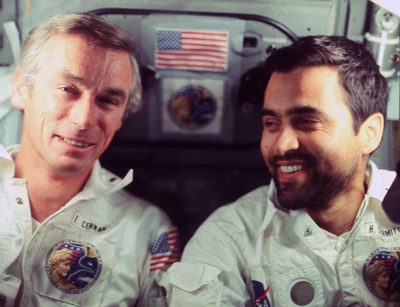
Apollo Program History
Following the accomplishments of NASA's Mercury and Gemini programs, the Apollo program (1967 to 1972) succeeded in fulfilling the goal laid out by John F. Kennedy of "landing a man on the Moon and returning him safely to the Earth."
Leaving Earth's gravity is an expensive challenge in terms of energy, and while the rockets used for the Mercury and Gemini programs were sufficient for their purposes of getting crew to low Earth orbit, something much bigger was required to get humans to the Moon. Thus, a new rocket system was developed: the Saturn V (five), a 3-stage launch system designed to get three humans and the necessary supplies to the Moon. To this day, the Saturn V remains the most powerful rocket ever launched.
The components of the Apollo spacecraft consisted of the Command Module (where the astronauts were housed) which was attached to the Service Module (where various spacecraft systems were located), and the Lunar Module (LM). In the later `J' missions, a Lunar Roving Vehicle (LRV) was added to the equipment list and a science bay was added to the Service Module. The Command Module and Service Module (together known as the CSM) remained together until after the trans-Earth coast after which the Service Module was jettisoned and the Command Module alone re-entered Earth's atmosphere.
The Apollo missions were divided into different classes, which indicated the objective of the mission to be performed:
- A-missions: test and `man-rate' the launch vehicle (Apollo 4, 6)
- C-missions: demonstrate CSM and crew performance and rendezvous capability (Apollo 7, 8)
- D-missions: demonstrate LM and crew performance in Earth orbit (Apollo 9)
- F-missions: demonstrate LM and crew performance in lunar orbit (Apollo 10)
- G-missions: manned lunar landing demonstration (Apollo 11)
- H-missions: demonstrate a precision manned lunar landing (Apollo 12, 13, 14)
- J-missions: extensive scientific investigation of the Moon from the surface and from orbit (Apollo 15, 16, 17)
Summary of the Apollo program
- Apollo 1: 27 January 1967, Not flown, Cabin fire
- Apollo 4: 09 November 1967, First test of the Saturn V
- Apollo 5: 22 January 1968, Unmanned test of the LM
- Apollo 6: 04 April 1968, Second test of the Saturn V
- Apollo 7: 11-22 October 1968, First manned CSM
- Apollo 8: 21-27 December 1968, First humans in lunar orbit
- Apollo 9: 3-13 March 1969, Manned docking of the LM and CSM in Earth orbit
- Apollo 10: 18-26 May 1969, Manned testing the LM in lunar orbit
- Apollo 11: 16-24 July 1969, First manned landing on the Moon, exploration of Mare Tranquillitatis.
- Apollo 12: 14-24 November 1969, Demonstrated precision landing (next to Surveyor 3), exploration of Oceanus Procellarum.
- Apollo 13: 11-17 April 1970, In-flight abort.
- Apollo 14: 31 January-9 February 1971, Systematic exploration of Fra Mauro highlands near Cone crater.
- Apollo 15: 26 July-7 August 1971, First 'J'-type mission, Systematic exploration of Hadley Rille and Palus Putredinis.
- Apollo 16: 16-27 April 1972, Systematic exploration of Descartes-Cayley.
-
Apollo 17: 7-19 December 1972, Systematic exploration of the Taurus-Littrow valley
Apollo Metric and Panoramic images are available at: apollo.im-ldi.com